2007 CHEVROLET TRAIL BLAZER air condition
[x] Cancel search: air conditionPage 324 of 574

The airbag system is designed to work properly
under a wide range of conditions, including off-road
usage. Observe safe driving speeds, especially
on rough terrain. As always, wear your safety belt.
Off-road driving can be great fun. But it does
have some de�nite hazards. The greatest of these
is the terrain itself.
“Off-roading” means you have left the great North
American road system behind. Traffic lanes
are not marked. Curves are not banked. There are
no road signs. Surfaces can be slippery, rough,
uphill, or downhill. In short, you have gone
right back to nature.
Off-road driving involves some new skills. And that
is why it is very important that you read this
guide. You will �nd many driving tips and
suggestions. These will help make your off-road
driving safer and more enjoyable.Before You Go Off-Roading
There are some things to do before you go out.
For example, be sure to have all necessary
maintenance and service work done. Check to
make sure all underbody shields, if the vehicle has
them, are properly attached.
Be sure you read all the information about your
four-wheel-drive vehicle in this manual.
Is there enough fuel? Is the spare tire fully
in�ated? Are the �uid levels up where they should
be? What are the local laws that apply to
off-roading where you will be driving? If you do not
know, you should check with law enforcement
people in the area. Will you be on someone’s
private land? If so, be sure to get the necessary
permission.
324
Page 389 of 574
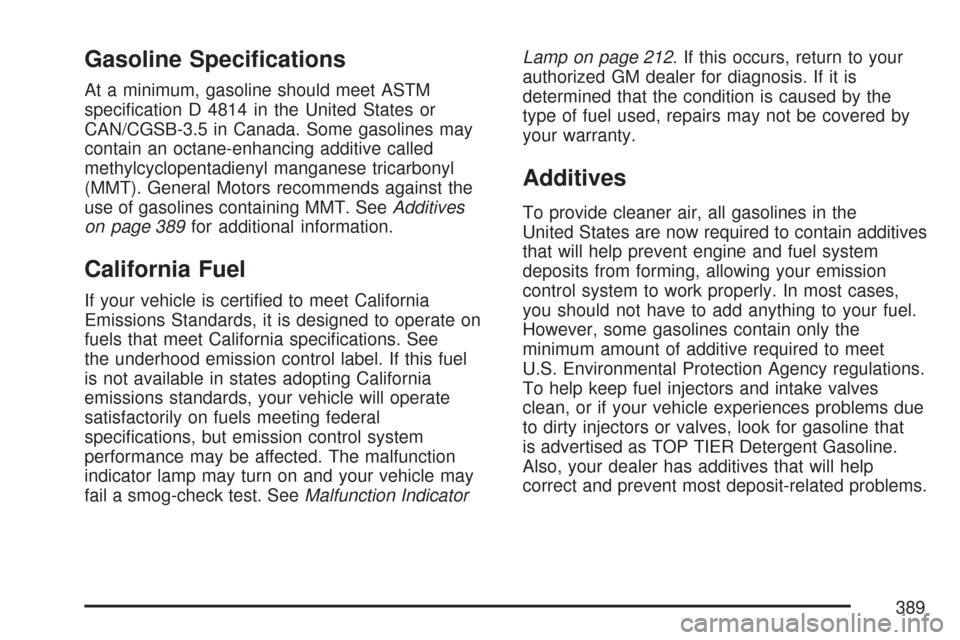
Gasoline Speci�cations
At a minimum, gasoline should meet ASTM
speci�cation D 4814 in the United States or
CAN/CGSB-3.5 in Canada. Some gasolines may
contain an octane-enhancing additive called
methylcyclopentadienyl manganese tricarbonyl
(MMT). General Motors recommends against the
use of gasolines containing MMT. SeeAdditives
on page 389for additional information.
California Fuel
If your vehicle is certi�ed to meet California
Emissions Standards, it is designed to operate on
fuels that meet California speci�cations. See
the underhood emission control label. If this fuel
is not available in states adopting California
emissions standards, your vehicle will operate
satisfactorily on fuels meeting federal
speci�cations, but emission control system
performance may be affected. The malfunction
indicator lamp may turn on and your vehicle may
fail a smog-check test. SeeMalfunction IndicatorLamp on page 212. If this occurs, return to your
authorized GM dealer for diagnosis. If it is
determined that the condition is caused by the
type of fuel used, repairs may not be covered by
your warranty.
Additives
To provide cleaner air, all gasolines in the
United States are now required to contain additives
that will help prevent engine and fuel system
deposits from forming, allowing your emission
control system to work properly. In most cases,
you should not have to add anything to your fuel.
However, some gasolines contain only the
minimum amount of additive required to meet
U.S. Environmental Protection Agency regulations.
To help keep fuel injectors and intake valves
clean, or if your vehicle experiences problems due
to dirty injectors or valves, look for gasoline that
is advertised as TOP TIER Detergent Gasoline.
Also, your dealer has additives that will help
correct and prevent most deposit-related problems.
389
Page 410 of 574
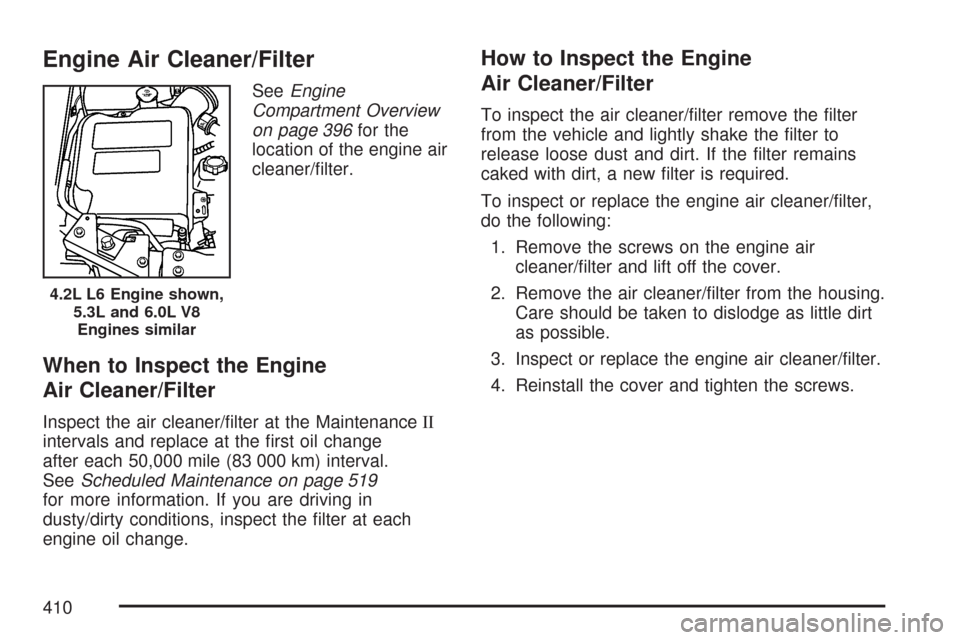
Engine Air Cleaner/Filter
SeeEngine
Compartment Overview
on page 396for the
location of the engine air
cleaner/�lter.
When to Inspect the Engine
Air Cleaner/Filter
Inspect the air cleaner/�lter at the MaintenanceII
intervals and replace at the �rst oil change
after each 50,000 mile (83 000 km) interval.
SeeScheduled Maintenance on page 519
for more information. If you are driving in
dusty/dirty conditions, inspect the �lter at each
engine oil change.
How to Inspect the Engine
Air Cleaner/Filter
To inspect the air cleaner/�lter remove the �lter
from the vehicle and lightly shake the �lter to
release loose dust and dirt. If the �lter remains
caked with dirt, a new �lter is required.
To inspect or replace the engine air cleaner/�lter,
do the following:
1. Remove the screws on the engine air
cleaner/�lter and lift off the cover.
2. Remove the air cleaner/�lter from the housing.
Care should be taken to dislodge as little dirt
as possible.
3. Inspect or replace the engine air cleaner/�lter.
4. Reinstall the cover and tighten the screws.
4.2L L6 Engine shown,
5.3L and 6.0L V8
Engines similar
410
Page 425 of 574

6. Start the engine and let it run until you can
feel the upper radiator hose getting hot.
Watch out for the engine cooling fan.
7. By this time, the coolant level inside the
radiator �ller neck may be lower. If the level is
lower, add more of the proper DEX-COOL
®
coolant mixture through the �ller neck until the
level reaches the base of the �ller neck.
8. Then replace the pressure cap. At any time
during this procedure if coolant begins to �ow
out of the �ller neck, reinstall the pressure
cap. Be sure the pressure cap is hand-tight
and fully seated.
Engine Fan Noise
Your vehicle has a clutched engine cooling fan.
When the clutch is engaged, the fan spins faster
to provide more air to cool the engine. In most
everyday driving conditions the clutch is not
engaged. This improves fuel economy and reduces
fan noise. Under heavy vehicle loading, trailer
towing, and/or high outside temperatures, the fan
speed increases when the clutch engages so
you may hear an increase in fan noise. This is
normal and should not be mistaken as the
transmission slipping or making extra shifts. It is
merely the cooling system functioning properly.
The fan will slow down when additional cooling is
not required and the clutch disengages.
You may also hear this fan noise when you start
the engine. It will go away as the fan clutch
disengages.
425
Page 430 of 574
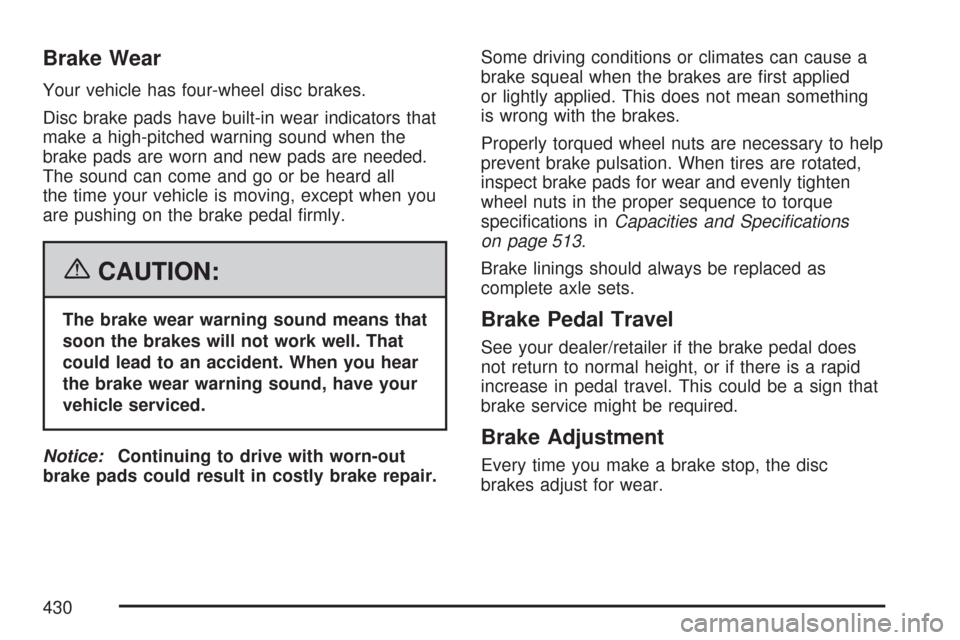
Brake Wear
Your vehicle has four-wheel disc brakes.
Disc brake pads have built-in wear indicators that
make a high-pitched warning sound when the
brake pads are worn and new pads are needed.
The sound can come and go or be heard all
the time your vehicle is moving, except when you
are pushing on the brake pedal �rmly.
{CAUTION:
The brake wear warning sound means that
soon the brakes will not work well. That
could lead to an accident. When you hear
the brake wear warning sound, have your
vehicle serviced.
Notice:Continuing to drive with worn-out
brake pads could result in costly brake repair.Some driving conditions or climates can cause a
brake squeal when the brakes are �rst applied
or lightly applied. This does not mean something
is wrong with the brakes.
Properly torqued wheel nuts are necessary to help
prevent brake pulsation. When tires are rotated,
inspect brake pads for wear and evenly tighten
wheel nuts in the proper sequence to torque
speci�cations inCapacities and Speci�cations
on page 513.
Brake linings should always be replaced as
complete axle sets.Brake Pedal Travel
See your dealer/retailer if the brake pedal does
not return to normal height, or if there is a rapid
increase in pedal travel. This could be a sign that
brake service might be required.
Brake Adjustment
Every time you make a brake stop, the disc
brakes adjust for wear.
430
Page 454 of 574
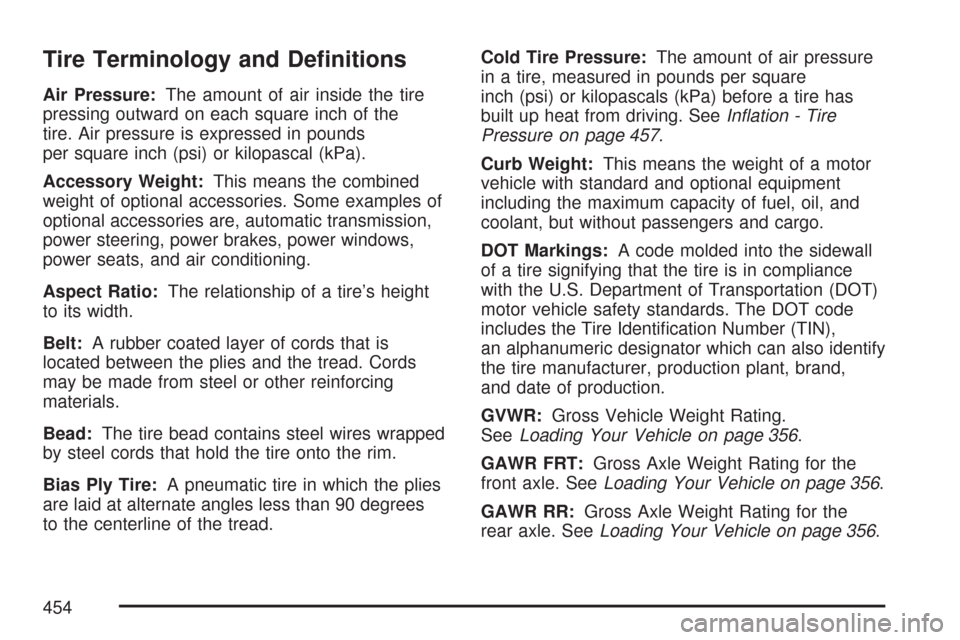
Tire Terminology and De�nitions
Air Pressure:The amount of air inside the tire
pressing outward on each square inch of the
tire. Air pressure is expressed in pounds
per square inch (psi) or kilopascal (kPa).
Accessory Weight:This means the combined
weight of optional accessories. Some examples of
optional accessories are, automatic transmission,
power steering, power brakes, power windows,
power seats, and air conditioning.
Aspect Ratio:The relationship of a tire’s height
to its width.
Belt:A rubber coated layer of cords that is
located between the plies and the tread. Cords
may be made from steel or other reinforcing
materials.
Bead:The tire bead contains steel wires wrapped
by steel cords that hold the tire onto the rim.
Bias Ply Tire:A pneumatic tire in which the plies
are laid at alternate angles less than 90 degrees
to the centerline of the tread.Cold Tire Pressure:The amount of air pressure
in a tire, measured in pounds per square
inch (psi) or kilopascals (kPa) before a tire has
built up heat from driving. SeeIn�ation - Tire
Pressure on page 457.
Curb Weight:This means the weight of a motor
vehicle with standard and optional equipment
including the maximum capacity of fuel, oil, and
coolant, but without passengers and cargo.
DOT Markings:A code molded into the sidewall
of a tire signifying that the tire is in compliance
with the U.S. Department of Transportation (DOT)
motor vehicle safety standards. The DOT code
includes the Tire Identi�cation Number (TIN),
an alphanumeric designator which can also identify
the tire manufacturer, production plant, brand,
and date of production.
GVWR:Gross Vehicle Weight Rating.
SeeLoading Your Vehicle on page 356.
GAWR FRT:Gross Axle Weight Rating for the
front axle. SeeLoading Your Vehicle on page 356.
GAWR RR:Gross Axle Weight Rating for the
rear axle. SeeLoading Your Vehicle on page 356.
454
Page 458 of 574
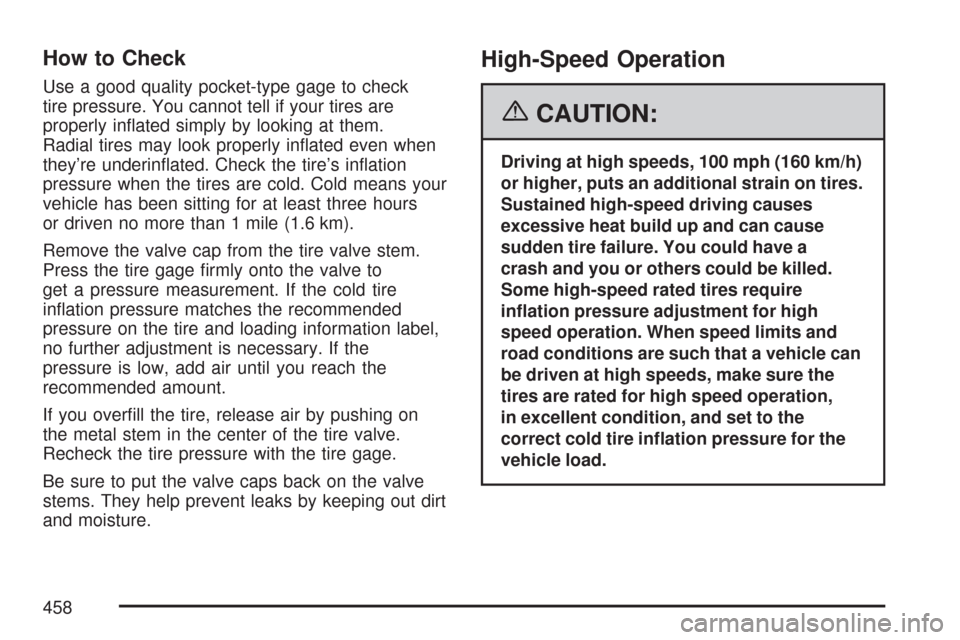
How to Check
Use a good quality pocket-type gage to check
tire pressure. You cannot tell if your tires are
properly in�ated simply by looking at them.
Radial tires may look properly in�ated even when
they’re underin�ated. Check the tire’s in�ation
pressure when the tires are cold. Cold means your
vehicle has been sitting for at least three hours
or driven no more than 1 mile (1.6 km).
Remove the valve cap from the tire valve stem.
Press the tire gage �rmly onto the valve to
get a pressure measurement. If the cold tire
in�ation pressure matches the recommended
pressure on the tire and loading information label,
no further adjustment is necessary. If the
pressure is low, add air until you reach the
recommended amount.
If you over�ll the tire, release air by pushing on
the metal stem in the center of the tire valve.
Recheck the tire pressure with the tire gage.
Be sure to put the valve caps back on the valve
stems. They help prevent leaks by keeping out dirt
and moisture.
High-Speed Operation
{CAUTION:
Driving at high speeds, 100 mph (160 km/h)
or higher, puts an additional strain on tires.
Sustained high-speed driving causes
excessive heat build up and can cause
sudden tire failure. You could have a
crash and you or others could be killed.
Some high-speed rated tires require
in�ation pressure adjustment for high
speed operation. When speed limits and
road conditions are such that a vehicle can
be driven at high speeds, make sure the
tires are rated for high speed operation,
in excellent condition, and set to the
correct cold tire in�ation pressure for the
vehicle load.
458
Page 459 of 574
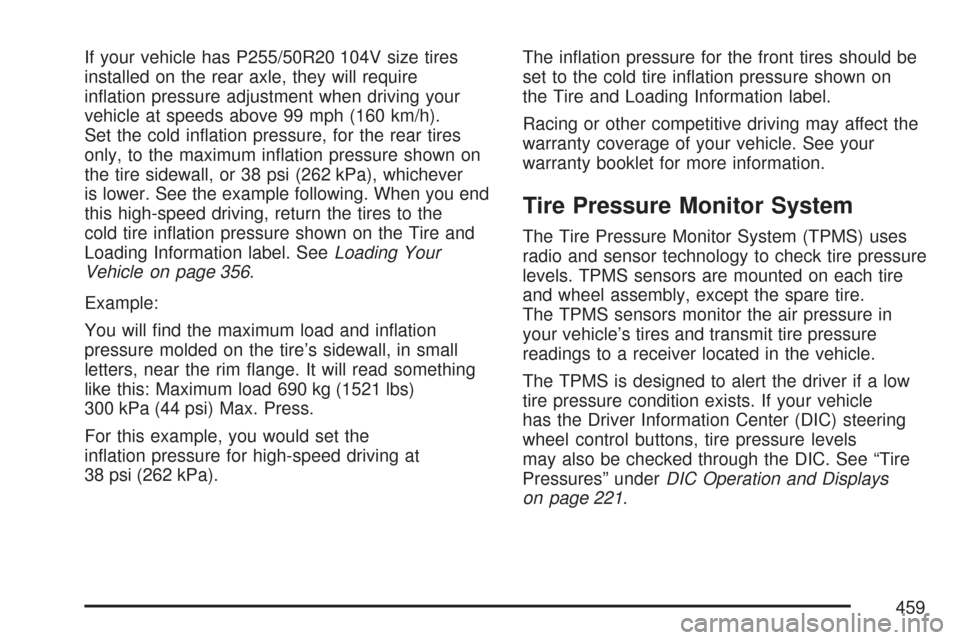
If your vehicle has P255/50R20 104V size tires
installed on the rear axle, they will require
in�ation pressure adjustment when driving your
vehicle at speeds above 99 mph (160 km/h).
Set the cold in�ation pressure, for the rear tires
only, to the maximum in�ation pressure shown on
the tire sidewall, or 38 psi (262 kPa), whichever
is lower. See the example following. When you end
this high-speed driving, return the tires to the
cold tire in�ation pressure shown on the Tire and
Loading Information label. SeeLoading Your
Vehicle on page 356.
Example:
You will �nd the maximum load and in�ation
pressure molded on the tire’s sidewall, in small
letters, near the rim �ange. It will read something
like this: Maximum load 690 kg (1521 lbs)
300 kPa (44 psi) Max. Press.
For this example, you would set the
in�ation pressure for high-speed driving at
38 psi (262 kPa).The in�ation pressure for the front tires should be
set to the cold tire in�ation pressure shown on
the Tire and Loading Information label.
Racing or other competitive driving may affect the
warranty coverage of your vehicle. See your
warranty booklet for more information.
Tire Pressure Monitor System
The Tire Pressure Monitor System (TPMS) uses
radio and sensor technology to check tire pressure
levels. TPMS sensors are mounted on each tire
and wheel assembly, except the spare tire.
The TPMS sensors monitor the air pressure in
your vehicle’s tires and transmit tire pressure
readings to a receiver located in the vehicle.
The TPMS is designed to alert the driver if a low
tire pressure condition exists. If your vehicle
has the Driver Information Center (DIC) steering
wheel control buttons, tire pressure levels
may also be checked through the DIC. See “Tire
Pressures” underDIC Operation and Displays
on page 221.
459